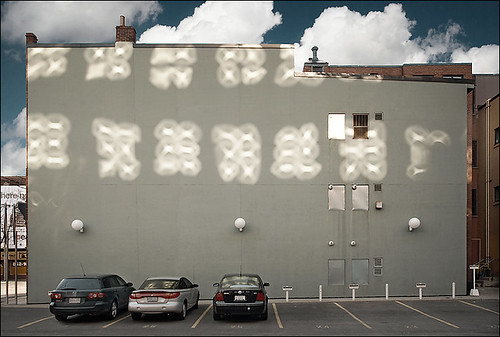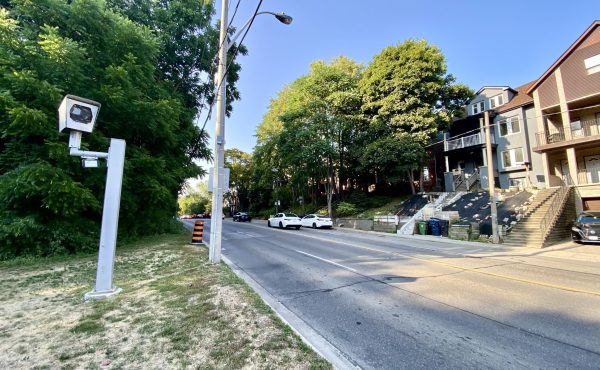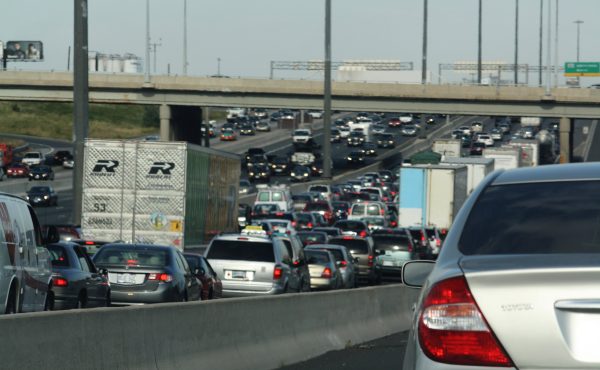
Surface parking lots are possibly the most problematic use of space in a city — their vast impervious surfaces create runoffs of polluted water; they absorb heat; although you have to walk out of them, they make no allowances for pedestrians, creating a sense of danger and unease; their vast surfaces are often left unused for big chunks of time; and they are just plain ugly, leaving dull gaping holes in the city’s fabric, deadening the urban spaces they inhabit.
So it’s great news that the City of Toronto is piloting new design guidelines for “greening” surface parking lots. The proposals include measures to address many of the major environmental problems, and in the process, they address some of the aesthetic problems as well. Ideas include landscaping with trees and grasses, using permeable surfaces such as bricks, and creating separated pedestrian walkways. (See also the Toronto Star article on the issue.)
At the moment, they are just a pilot project (PDF), so they may be modified before a final version is put in place. The guidelines would only apply to new developments or re-developments, not retroactively, so unfortunately they won’t make a big difference to the many surface lots that are already established. A solution might be to impose a City fee on parking spots (the idea was briefly considered by the City earlier this year) and then allow that fee to be greatly reduced if the guidelines are followed, creating an incentive for parking lot owners to make changes that would really improve the city.
The only drawback with the project is that it’s not really clear how strongly the new guidelines will be enforced. They will be taken into consideration during the development proposal process, but since most developers seem to ignore voluntary City guidelines, I’m not really sure how much impact these good ideas will have in practical terms.
photo by Sam Javanrouh




18 comments
Yeah I read about this and the suggestion that lot owners will just do it because it might be beneficial “sometime in the future” is pretty ludicrous and naive. I really hope they come up with good incentive because it’s a fantastic idea.
Is this for real, how much did this cost the taxpayer to put together?Study after study, cost after cost, we have homeless in this city and this is where our money goes?Wow!
Thanks for posting this dylan.
Too often people accuse those of us who oppose rampant car culture that we want to turn back the clocks of Progress. But in most cases, the people who oppose car culture just want a better balance of transportation needs. Certainly not every car trip needs to be taken by car — bike, walk , transit, etc. And its those excessive uses of vehicles that are doing the harm — a 5 minute car ride is a 15 to 20 minute walk. If you drive, not only are you harming the air quality but also your own health by being sedentary.
Green parking lots is one of those steps we can take to helping attain that balance. Lots of pavement is bad (as Dylan points out) and if the space is not attractive there is a mental burden to pay as well.
Those malls, with their expansive parking lots, really could be using their roof space better — put the cars there and let the area around the mall be landscaped will nice paths, trees, etc. Certainly the most important part of fixing our city’s parking lots is properly zoning them and not letting developers pave over every inch of land.
George —
Your logic is so twisted on these issues. yes there are homeless, but should all of city’s money be spent on solving the homeless? no. Money is spent elsewhere so that shit gets done.
You NEED studies in order to implement them . We need to have them so that we can debate the merits. You call that waste, i call it democracy. It costs money — deal with it.
The only drawback with the project is that it’s not really clear how strongly the new guidelines will be enforced.
What about the Toronto Parking Authority? It calls itself “the largest municipal parking operator in North America”, and it’s owned and run by the City. Surely the City could require them to phase these in?
A solution might be to impose a City fee on parking spots (the idea was briefly considered by the City earlier this year) and then allow that fee to be greatly reduced if the guidelines are followed.
This seems like a really good idea. As long as the fee exceeds the extra amount it would cost to comply with these guidelines, it becomes cheaper to green new parking lots, than not to.
this isn’t democracy, tax dollars must be used for people homeless first landscaping second. Do you have no heart? Or are these expensive studies just a new way of housing street people to sleep in “pretty parking lots”?
Aren’t you listening to David Miller? He said that there is a fiscal crisis in this city. Do we solve it by spending millions on useless studies like this, while people in this city don’t have proper daycare or support?
Huh? Last time I checked this was not Pakistan, George. We vote them and we vote them out. We have community consultations, committee meetings, etc. This study is not a waste of money.
There was not millions spent on this study. Studies are part of people’s jobs, its worked into the operating budget.
You make it sound like we should spend the $7 billion solving homeless and do nothing else. Of course I want homeless people sheltered but I also want my water to run, TTC buses on my street, etc.
Your logic is ridiculous — no wonder you keep getting your ass handed to you on a plate each election. You campaign on a platform of environmentalism and calling green parking lots a waste? No wonder you attract 1,700 votes out of a possible 35,000 in the 2006 election.
SNAP!!!
That was a bit harsh Nathan…
Green Parking Lots, isn’t that an oxymoron?
I don’t understand why we don’t see more underground parking lots in Toronto. Is it because it is too expensive to build due to the terrain formation underneath the city? Why not make green roofs, plazas and other gathering places above parking lots? It seems to be a very common thing in many other cities.
Thank you for bringing up the election.I thought I did well considering it was the first time ever in politics and a 30 day campaign against the most powerful politician in toronto history.At least 1760 citizens knew what I was about.Sa well I had to content with Olivia Chow who put her hand into the campaign as well with support and fundraising.Its always hard to fight a group as wealthy as the NDP party!Well the benefits for their supporters shows with this very projcet.
Just the term “green parking lot” is ridiculous.While we are trying to stop the use of vehicles downtown we then go ahead and spend millions on studies to promote cars!That isn’t green that is hypocrisy.Most of these lots are privately owned by individuals that are in the slow process of developing the land and dealing with the same city hall that wants to green their lots.Other built lots can’t be greened ’cause there is no room to do so since the city allowed full coverage of their lot to build the structure to allow parking.Whew this can go on forever , it just amazes me that the budget allows such waste of money while many more important issues are at hand.If that what the NDP party is about you can have them and please don’t vote for me if you are all about throwing money away.
Again, you lie George by saying we spend millions on studies. Should the city not study whether its a good thing to do this or a bad thing? I’m sure you’d be first in line to yell at City Hall for not properly planning, well, anything.
While you’re at it, please stop saying stuff that makes you look more insane: “most powerful politician in Toronto history”? Please note that council has 14 card-carrying NDPers and 40,000 staff. City Council is a co-op, not parliament and cannot pass anything with some form of consensus from disparate political views. When City Hall was run by Lastman we had MFP and other corruptness (you should hear the stories of padding wallets from Mel’s 25 year reign).
I still can’t fathom why you object to greening parking lots — the many issues at hand are intertwined. Water quality has something to do with parking lots. Smog days have something to do with parking lots.
I’ll stop parking on George so that this thread can have more comments on the initiative itself, but its hard to ignore George’s uneducated comments that are obviously fueled by personal vindictiveness towards Pantelone and others who, gasp!, worked against him in the election.
Sorry I have no animosity against Joe at all he is the most powerful politician in toronto! Ask him.Or better still ask David Miller.
Anyhow I think the figure is closer to $3.85 million in staff and commitees for studies that are never adopted. But don’t quote me that was only “told” to me by a staffer to get the true figures yes you have to do a “freedom of information” request that you must pay for at 50 cents per page (average $150) per report.
By the way Joe Pantalone and Olivia Chow voted for the MFP contract.
But I think we need a better direction by our elected representatives to make sure we take care of essentials first then the luxury items like the private ownership lots.We already dictate to owners of private property regarding tree planting.Imagine we order them to plant trees then they aren’t allowed to touch those same trees.In fact at the moment many owners are in trouble with the city by just touching the trees on their own property.(see todays column by sue ann levy in the toronto sun).
But please the name calling doesn’t help your argument.A democracy is about all people being able to have input without your kind of harrassment.It’s called “freedom of expression” and is protected by the charter of rights and freedoms.If the editors feel I have no right to post here let them indicate that to me.
I’m sure some of the things proposed in the guidelines are fabulous, but the report fails in one critical area: it is virtually silent on the issue of demand vs. capacity. Especially on big box retail sites, companies provide huge areas of parking that will never see a car, to provide the impression to customers that they have “plenty of parking”. This would be the easiest, cheapest, and most effective way to reduce surface run-off… not to mention that it results in a more efficient use of land and improves urban design (at least a little).
The cost of structured parking vs. regular surface lots is something like 10 times higher, so property developers have to have a pretty good financial case for putting spaces underground. Not just a Toronto issue. If there are places where structured parking is more prevalent, it’s because there’s other underlying issues at work (e.g. cost/scarcity of land).
To add to Brent’s comment regarding huge parking lots at retail sites: zoning by-laws in the city require these stores to have a minimum number of parking spaces. These range in Toronto from 0.9 spaces per 100 m2 store floor area in downtown Toronto to 6.67 spaces per 100 m2 floor area for retail stores larger than 3000 m2 in North York. There is a “cash-in-lieu” policy that allows developers to pay into a fund for municipal parking instead of providing parking at the store, but I’m not sure how widely used this option is.
The city is in the process of re-evaluating their parking requirements. Any reduction in the number of required spaces would be a welcome complement to these parking lot design guidelines.
>>Disparishun
The TPA already seems to be heading towards green parking lots. When they recently tore down a house to expand the parking lot at Bloor & Ossington, they put in interlocking brick and trees, rather than just pavement. There was probably still a net loss of permeable surface area, but it’s a start.
Hopefully, this will become normal operating procedure for the TPA rather than lip service.
The documents indicate that the guidelines will be mandatory for city agencies, notably the TPA, at least for new parking lots. What would be ideal, of course, would be if the TPA started retrofitting old lots, but I won’t hold my breath. For one thing, I think the City likes to take all the TPA’s profits for itself to balance its own stretched budget.
>
These requirements should be totally eliminated. They are inconsistent with current city policies. It’s one thing if a business wants to provide parking, but to be forced to do so is nuts. The city should be puching in the other direction – i.e. less land devoted to parking.
^^^
That refers to minimum parking space requirements noted above by 8sml.
These requirements should be totally eliminated. They are inconsistent with current city policies. It’s one thing if a business wants to provide parking, but to be forced to do so is nuts.
I was going to disagree — some parking is surely good housekeeping, especially in areas where, realistically, transit is not available. Things like allowing them to replace parking spots with the equivalent-cost number of structured parking lots, as described above.
But, on second thought, maybe you are right — perhaps zoning should be limiting the number of parking spots, even using the same or similar benchmarks. As for a minimum, perhaps this is one place where the market should be allowed to rule. If a developer thinks she can get people out to her project without any parking on site, let her go right ahead, and soar or crash and burn on the project’s merits.
In other words, for councillors who dislike the idea of having the City centrally plan everything, surely mandating a minimum number of parking spots is one of the first things that central planning could eliminate?